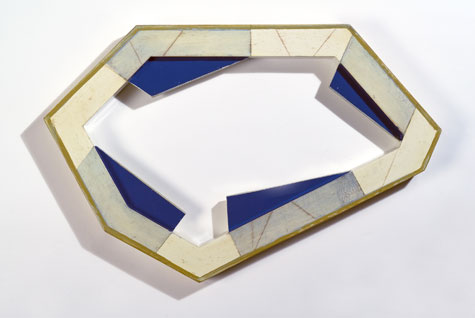
‘SEGMENT 61’ Oil and enamel on pine, by Frederick Lynch, 2007. |
Three large oil paintings overwhelm the lobby at the Portland Museum of Art, introducing the show "Division and Discovery: Recent Works by Frederick Lynch," a beautiful and meditative collection found on the fourth floor of the museum. The paintings are overpowering kaleidoscopic abstractions of branching geometries, washed in flesh tones and bold primary colors. Referencing macro and micro interpretations of nature, these paintings obsessively explore the linear possibilities of two-dimensional space, and serve as a groundwork for the studies found upstairs. Building on forms that emerge from these "Division" paintings, Lynch, who has lived and worked in Maine since the early '70s and shown widely throughout New England, manifests a self-referential and thorough body of work, which includes ink and gouache on paper, sculptures, and painted reliefs.
A fabiform element, or "Segment," isolated from a larger Lynchian matrix, becomes a trademark of the show. Examined in physical form and in delicate architectural line drawings, segments are pieced together in latticed reliefs, stand alone on pedestals, and are grouped with painstakingly accurate studies of themselves. Combined, they become cellular or molecular; alone they reference a frame, or a window. Lynch calls this process "transcription" — using his own work as subject for new works, creating generations of segments and drawings of segments that refer to their earlier incarnations, but take on new sets of problems. Creating art for art's sake, Lynch has created his own visual vocabulary and investigated every consonant and vowel.
Lynch's work doesn't discriminate between process and end; he allows every possibility of a concept to come into fruition, whether its suggestion exists in a sketch, or a fully executed sculpture cohabitates a wall with 24 variations of itself.
"Segments," an installation of 25 pieces, is an irregular grid composed of individual sculptures, oil and enamel on pine, all completed between 2006 and 2008. The pieces each have a fundamental similarity in their bean- or seed-like form, but vary slightly in scale and in color. Each permutation plays with different variables.
The notion of play is also integral to Lynch's work. His use of color and line challenge perspective in both his "Division" paintings and "Segments." Lines incised into pine sculptures suggest non-existent joints, and architectural elements are only painted on. His paintings masterfully control dimension and depth with color relationships and line density, simulating at times the pores of a sponge, a coral skeleton, or the grooves in vinyl upholstery.
Of all of Lynch's systematic manifestations, his paintings are by far the most engaging. It is here that the attempt to harness infinity, or make it tangible, is most visible. Relying on the rigidity of mathematics as well as the promise of the human hand's imperfection, Lynch's shapes vibrate between order and chaos. He uses a thin line in comparison to the size of his canvas, and repeated the lines dissolve into a larger pattern, and then pop into specific branches and larger organizational shapes. These larger forms are almost contained by the edges of the canvas, but generally bleed off of at least two corners or edges, allowing them to slip into the undefined.
Annie Larmon can be reached at aglarmon@gmail.com.
"DIVISION AND DISCOVERY: RECENT WORK BY FREDERICK LYNCH" | Through May 16 | at the Portland Museum of Art, in Portland | 207.775.6148